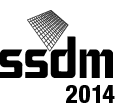Invited Speakers
Area 1 Advanced LSI Processing & Materials Science
-
Band offsets at high-k oxide/semiconductor interfaces: From silicon to high-mobility channel materialsV. V. Afanas'ev(KU Leuven, Belgium)
-
Nickel Compound and Alloy Contacts to Nanoscale Si, Ge, and InGaAs ChannelsS. A. Dayeh(UCSD, USA)
-
Heated Ion Implantation Technology for High Performance SOI FinFETsW. Mizubayashi(AIST, Japan)
-
Negative Capacitance TransistorsS. Salahuddin(UC Berkeley, USA)
Area 2 Advanced Interconnect and 3D Integration/ Materials and Characterization
-
High-density Silicon Optical Interposer for Inter-chip InterconnectT. Nakamura(PETRA, Japan)
-
Technology and Application Requirements of 2.5D/3D Field Programmable System-in-Package (SiP)A. Rahman(Altera, USA)
-
A Possibility of Cross-Bar Wiring in Three-Dimensional Crystallographic SpaceH. M. Yamamoto(IMS, Japan)
-
METAL-CNT CONTACTSC. Y. Yang(SCU, USA)
Area 3 CMOS Devices / Device Physics
-
Tunnel-FET Transistors for 13nm Gate-Length and BeyondU.E. Avci(Intel, USA)
-
Drive Current Performance of Inversion Mode Ge CMOS TransistorsX. Gong(NUS, Singapore)
-
Self-Heating Effects in Nanoscale Planar SOI and Fin FETs [Tentative]T. Takahashi(Keio Univ., Japan)
-
A 16nm FinFET CMOS Technology for Mobile SoC and Computing ApplicationsS.-Y. Wu(TSMC, Taiwan)
Area 4 Advanced Memory Technology
-
Scaling of resistive switching devicesD. Ielmini(POLIMI, Italy)
-
Current Status of Cation-Based Resistive MemoryM. N. Kozicki(ASU, USA)
-
Trends on Advanced Semiconductor MemoriesA. Nitayama(Tohoku Univ., Japan)
-
Switching current and thermal stability of perpendicular magnetic tunnel junction with MgO/CoFeB/Ta/CoFeB/MgO recording structure scaling down to 1X nmH. Sato(Tohoku Univ., Japan)
Area 5 Advanced Circuits and Systems
-
Time Difference Amplifier and Its Application for TDCT. Nakura(Univ. of Tokyo, Japan)
-
MEMS Neural Probes by CMOS Technology and MicromachiningO. Paul(Univ. of Freiburg, Germany)
-
Ultra-Wideband Technology for Short-Range CommunicationsW. Rhee(Tsinghua Univ., China)
Area 6 Compound Semiconductor Electron Devices & Related Technologies
-
High Performance Ⅲ-Ⅴ MOS TechnologiesM. J. W. Rodwell(UCSB, USA)
-
Room-Temperature Resonant-Tunneling-Diode Terahertz OscillatorS. Suzuki(Tokyo Tech, Japan)
-
Physical effects limiting performance and reliability of GaN High Electron Mobility TransistorsE. Zanoni(Univ. of Padova, Italy)
Area 7 Photonic Devices and Related Technologies
-
Hybrid Ⅲ-Ⅴ on Silicon LasersB. Ben Bakir(CEA-Leti, France)
-
Germanium Tin Light Emitters on SiliconE. Kasper(Univ. Stuttgart, Germany)
-
Luxtera's Silicon Photonics Platform for Transceiver ManufacturingM. P. Mack(Luxtera, USA)
-
Optical isolators and circulators on Si waveguide platformsT. Mizumoto(Tokyo Tech, Japan)
Area 8 Advanced Material Synthesis and Crystal Growth Technology
-
Direct Growth of Uniform In-rich InGaN on Si: A New Basic TechnologyP. Aseev(ISOM, Spain)
-
Epitaxial Growth, Doping, and Electron Transport of the Semiconducting Oxides In2O3, Ga2O3, and SnO2O. Bierwagen(PDI, Germany)
-
Growth, characterization, and functionalization of graphene and hexagonal boron nitrideH. Hibino(NTT BRL, Japan)
-
Metal-Induced Crystallization - Fundamentals and ApplicationsZ. Wang(Max Planck Inst., Germany)
Area 9 Physics and Applications of Novel Functional Devices and Materials
-
Band nesting in semiconducting transition metal dichalcognideG. Eda(NUS, Singapore)
-
Quantum anomalous Hall effect in magnetically doped topological insulatorK. He(Tsinghua Univ., China)
-
Spin-valley physics in 2D crystalsY. Iwasa(Univ. of Tokyo, Japan)
-
Angular momentum conversion from single photons to single electron spins in a lateral double quantum dotA. Oiwa(Univ. of Tokyo, Japan)
Area 10 Organic Materials Science, Device Physics, and Applications
-
Organic BioelectronicsM. Berggren(Linköping Univ., Sweden)
-
Exciplex Forming Co-Hosts as a Platform for OLEDs with Ultimate EfficiencyJ.-J. Kim(SNU, Korea)
-
Polymeric Optical Devices with Printable and Flexible ElectrodeY. Ohmori(Osaka Univ., Japan)
-
Recent progress in polymer light emitting materialsTakeshi Yamada(Sumitomo Chemical Co., Ltd., Japan)
Area 11 Sensors and Materials for Biology, Chemistry and Medicine
-
Device Technologies for Cell and Tissue AnalysisT. Fujii(Univ. of Tokyo, Japan)
-
Silicon and reduced graphene oxide device concepts for electronically interfacing individual cells in cultureS. Ingebrandt(UASK, Germany)
-
Multi-channel recording system with UWB wireless data transmitter for Brain-Machine InterfaceT. Suzuki(NICT, Japan)
-
Microfluidic biochip technology for biological cell researchM.-H. Wu(CGU, Taiwan)
Area 12 Spintronics Materials and Devices
-
On-Chip Nonreciprocal Photonic Devices Using Magneto-Optical Oxide Thin FilmsL. Bi(UESTC, China)
-
Engineering materials for all-optical helicity-dependent magnetic switchingM. Cinchetti(Univ. of Kaiserslautern, Germany)
-
Magneto-reprogrammable semiconductor logic at room temperatureJ. Hong(Korea Univ., Korea)
-
Progress of STT-MRAM Technology and application to low-power memory systemH. Yoda(TOSHIBA, Japan)
Area 13 Applications of Nanotubes, Nanowires, and Graphene
-
Advanced emission properties and lasing from (In,Ga)As nanowiresG. Koblmueller(WSI, Germany)
-
Carbon Nanotube Computer: Transforming Scientific Discoveries into Working SystemsM. Shulaker(Stanford Univ., USA)
-
Majorana fermions in semiconductor nanowiresH. Xu(Lund Univ./Peking Univ., Sweden/China)
Area 14 Power Devices and Materials
-
The Continuing Evolution of Silicon Carbide Power MOSFETsJ. A. Cooper(Purdue Univ., USA)
-
Accurate physical compact models of high-voltage/power semiconductor devices for efficient design of performance-optimized circuits and systemsH. J. Mattausch(Hiroshima Univ., Japan)
-
Commercialization of the high voltage Gallium Nitride HEMTP. Parikh(Transphorm, USA)
-
Challenges to the silicon IGBT limit with PNM structureM. Sumitomo(DENSO, Japan)
Area 15 Photovoltaic Materials and Devices
-
Design and Characterizations of Perovskite Solar CellsW.-G. Diau(NCTU, Taiwan)
-
High Efficiency, Flexible, Thin Film Ⅲ-Ⅴ Solar Cell TechnologyG. S. Higashi(Alta Devices, USA)
-
Cu2ZnSnS4 Solar Cells Fabricated by an Electrochemical TechniqueS. Ikeda(Osaka Univ., Japan)
-
Development of Heterojunction Back Contact Si Solar CellsJ. Nakamura(SHARP, Japan)
-
FUTURE PROSPECTS OF ORGANIC AND HYBRID SOLAR CELLS FOR NEXT GENERATION PHOTOVOLTAICSH. Segawa(Univ. of Tokyo, Japan)
PAGE CONTENTS
Core Areas
- - Area 1 :
Advanced LSI Processing & Materials Science - - Area 2 :
Advanced Interconnect and 3D Integration/ Materials and Characterization - - Area 3 :
CMOS Devices / Device Physics - - Area 4 :
Advanced Memory Technology - - Area 5 :
Advanced Circuits and Systems - - Area 6 :
Compound Semiconductor Electron Devices & Related Technologies - - Area 7 :
Photonic Devices and Related Technologies - - Area 8 :
Advanced Material Synthesis and Crystal Growth Technology - - Area 9 :
Physics and Applications of Novel Functional Devices and Materials - - Area 10 :
Organic Materials Science, Device Physics, and Applications
Strategic Areas
PAGE TOP


